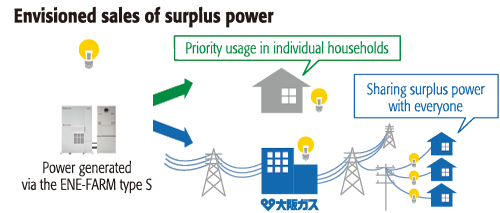Home > Highlighting JAPAN > Highlighting Japan June 2017 > Science & Technology
Highlighting JAPAN


HIGH CO-GENERATION EFFICIENCY, ULTRA-COMPACT DESIGN
Offering high power-generation efficiency in a reduced size, ENE-FARM systems are rapidly taking root in Japan.
In recent years, residential fuel cells combining heat and power (CHP) called “ENE-FARM” have spread widely in Japan.
ENE-FARM is a CHP system generating power through the reaction of hydrogen and oxygen in the air. The hydrogen is made from natural gas and LPG supplied to homes. ENE-FARM offers many benefits from both an environmental and economic standpoint.
Not only does ENE-FARM offer high power-generation efficiency compared to existing thermal-powered generation and transmission systems, but also the transmission loss of electric power is small, enabling it to achieve exceptional energy availability (total efficiency) as it uses the heat produced during generation to supply hot water.
With many manufacturers locked in fierce competition to develop ENE-FARM, a new product has emerged that dramatically improves the performance of existing models and offers world-leading power generation efficiency, whilst also being the world’s smallest system to date. The product is called “ENE-FARM type S,” launched by Osaka Gas in 2016. We asked Sana Hosokawa of the Fuel Cell Development Team at the Residential Energy System Development Department of Osaka Gas about the new system.
“The biggest obstacles to further market penetration were price and ease of installation. Basically, we needed to cut the product cost and make it more compact. In order to achieve that, enhancing power-generation efficiency was critical. We reduced electrical resistance in the cell stack, which enabled us to reduce the number of cells whilst still achieving a sufficient voltage. This gave us a world-leading power efficiency (in residential CHP systems whose rated power is less than 1kW) of 52% (Feb. 2016). However, it also created durability issues as the metal parts used to connect cells became too hot to ensure ten years’ lifetime because reducing the number of cells had increased the load per cell.
“A unique ceramic coating jointly developed with Kyocera was the key technology to solve this difficult technical challenge. Both high power-generation efficiency and ten years’ lifetime were achieved at the same time due to this coating technology. The technology enabled us to strike a balance between high power efficiency and durability.”
By improving power generation efficiency from 46.5% in previous models to 52%, the amount of waste heat has been reduced. The hot water storage tank could therefore be smaller and built into the power generation unit. The company could then combine the power generation unit with conventional gas water heaters and not only reduce prices but also produce the world’s smallest design.
“We estimate that a typical four-person household can reduce their annual energy bills from around 249,000 yen (US 2,243 dollars) to 135,000 yen by installing the new ENE-FARM type S. And the price is reduced by almost 800,000 yen compared with the original model,” explains Hosokawa.
What is more, Osaka Gas has purchased surplus power generated by the residential CHP systems since April 2016, following the deregulation of the power retail market. This means that the new ENE-FARM type S can maintain high power generation efficiency twenty-four hours a day, and the household can sell to Osaka Gas the surplus power that is not used by the household itself. In this way the new ENE-FARM type S can reduce energy bills.
The eco-friendly and budget-pleasing new ENE-FARM type S has been highly evaluated not only by end users but also by home builders. Downsizing can reduce the installation space from 1,9 m2 to 1.4 m2, so it becomes easier to install the system in small detached houses and condominiums.
The innovative CHP system received many awards in 2016, including the Director-General of the Agency for Natural Resources and Energy Award, and the Minister of the Environment Award for Global Warming Prevention Activity.
Hosokawa spoke of the company’s future goals.
“In May 2017, the total number of ENE-FARM in Japan exceeded 200,000 units. The government has set a target of 5.3 million systems by 2030, equivalent to roughly 10% of all households in Japan. In order to achieve this target, we need to continue to make the systems smaller and more efficient.
“We try to implement a positive growth cycle. Cost reduction by R&D activity leads to market expansion, and market expansion leads to R&D investment in turn.”

© 2009 Cabinet Office, Government of Japan






